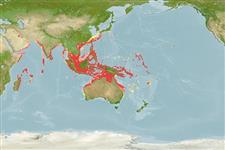>
Eupercaria/misc (Various families in series Eupercaria) >
Lutjanidae (Snappers) > Lutjaninae
Etymology: Lutjanus: Malay, ikan lutjan, name of a fish.
More on author: Bloch.
Environment: milieu / climate zone / depth range / distribution range
Ecología
marino asociado a arrecife; rango de profundidad 5 - 100 m (Ref. 55). Tropical; 34°N - 35°S, 47°E - 180°E (Ref. 55)
Indo-West Pacific: Persian Gulf and Gulf of Oman to Fiji, north to southern Japan and Jeju Island, Korea (Ref. 114833), south to New South Wales, Australia (Ref. 114833) and New Caledonia (Ref. 86942). This species has been referred to as Lutjanus malabaricus (non Schneider) or Lutjanus altifrontalis by many recent authors. Occurrence in the Red Sea is a misidentification (Ref. 84159).
Length at first maturity / Tamaño / Peso / Age
Maturity: Lm 50.2, range 50 - ? cm
Max length : 81.6 cm FL macho / no sexado; (Ref. 5739); common length : 45.0 cm TL macho / no sexado; (Ref. 55); edad máxima reportada: 8 años (Ref. 5739)
Espinas dorsales (total): 11; Radios blandos dorsales (total): 12-14; Espinas anales 3; Radios blandos anales: 8 - 9. Deep-bodied. Dorsal profile of head sloped. Length of upper jaw smaller than distance bet. base of last dorsal and anal rays. Preorbital bone usually narrower than eye diameter. Preopercular notch and knob poorly developed. Scale rows on back rising obliquely above lateral line. Juveniles with an oblique band extending from mouth to beginning of dorsal fin and a black spot at the caudal peduncle (Ref. 469). Body depth 2.5-3.0 in SL (Ref. 90102).
Adults inhabit trawling grounds and reefs. They are present over shoals, rubble, corals, large epibenthos, hard or sandy mud substrates and offshore reefs (Ref. 6390). Usually in groups (Ref. 90102). Juveniles from about 2.5 cm length inhabit shallow waters over muddy substrates (Ref. 6390). Feed on a broad range of prey dominated by fish, and with small amounts of crustaceans, cephalopods and other benthic invertebrates (Ref. 6390). They forage mostly at night (Ref. 6390). They are marketed either gilled and gutted, whole as fillets, as fresh chilled or frozen product (Ref. 6390).
Are serial batch spawners (Ref. 6390).
Allen, G.R., 1985. FAO Species Catalogue. Vol. 6. Snappers of the world. An annotated and illustrated catalogue of lutjanid species known to date. FAO Fish. Synop. 125(6):208 p. Rome: FAO. (Ref. 55)
IUCN Red List Status (Ref. 130435)
Threat to humans
Harmless
Human uses
Pesquerías: comercial; Acuicultura: comercial
Herramientas
Special reports
Download XML
Fuentes de Internet
Estimates based on models
Preferred temperature (Ref.
123201): 25.3 - 29.1, mean 28.2 °C (based on 1590 cells).
Phylogenetic diversity index (Ref.
82804): PD
50 = 0.5000 [Uniqueness, from 0.5 = low to 2.0 = high].
Bayesian length-weight: a=0.01514 (0.00776 - 0.02952), b=2.96 (2.80 - 3.12), in cm total length, based on LWR estimates for this species & Genus-body shape (Ref.
93245).
Nivel trófico (Ref.
69278): 4.5 ±0.7 se; based on diet studies.
Resiliencia (Ref.
120179): Medio, población duplicada en un tiempo mínimo de 1.4-4.4 años (K=0.21-0.39; tm=4; tmax=8; Fec=5 million).
Prior r = 0.66, 95% CL = 0.43 - 0.99, Based on 1 stock assessment.
Fishing Vulnerability (Ref.
59153): Moderate vulnerability (42 of 100).
Nutrients (Ref.
124155): Calcium = 25.7 [15.5, 39.1] mg/100g; Iron = 0.342 [0.214, 0.558] mg/100g; Protein = 18.7 [17.2, 20.1] %; Omega3 = 0.136 [0.091, 0.202] g/100g; Selenium = 73.1 [45.4, 124.1] μg/100g; VitaminA = 154 [31, 621] μg/100g; Zinc = 0.308 [0.236, 0.442] mg/100g (wet weight);
